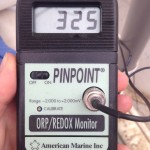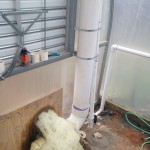What exactly is ORP? It’s an acronym for Oxidation-Reduction Potential (or Redox Potential in some parts of the world). In this case, it applies to the water you have in your koi pond, and more specifically its ability to dissolve (oxidize) the contaminants in it.
Essentially, ORP is a measurement of water’s cleanliness as a function of the pollution or contaminants in it. The pollution, known as Dissolved Organic Compounds (or DOCs), is too small and fine to be removed from the water by traditional mechanical filtration.

ORP is measured on an ORP meter in millivolts (or mV) and is a more accurate indicator of how effective your efforts are in keeping your pond “clean”—or pollution free.
In clearing up any confusion about the difference between the ORP and PPM readings, gamegroup.com has a quick synopsis: “Think of it like this: Your pool or spa is a battlefield. Bacteria, virus, organic matter, etc. are the enemy. PPM is the number of soldiers you have on the battlefield. ORP is an accurate measurement of the morale of your soldiers – how willing they are to kill.”
In terms of keeping your water clean, oxidation is an ally. By leeching electrons, they break down organic material and destroy harmful bacteria. The higher the oxidation readings, the “cleaner” or less polluted the water is.
The ORP meter is designed to determine the index of water pollution and provides an optimal, suboptimal and super-optimal range. Allaboutkoi.co.uk does a great job of dissecting what are considered the most effective ranges and what each accomplishes specifically for koi ponds.
The article highlights different methodologies of how to increase the ORP readings, from mechanical and biofiltration to waterfalls and airstones. There is another means to improve the ORP, taking mechanical and biofiltration one step further.

Known as protein skimming (or foam fractionation and phoam phraxination), the process involves pumping water through an external filter and bio balls to create foam that then suspends any dissolved organic and inorganic pollutants in the water. These impurities that are missed in the normal filtration process are quite literally bubbled out of your pond.
A foam fractionator can be constructed from materials you will find at your local hardware store. Enthusiasts (and production ponds alike) may employ slightly different materials and construction plans, but the basic principles are the same. This koiphen.com thread provides a comprehensive how-to guide and a complete list of the materials needed to construct one.
If you are looking to stock or add more living jewels to your koi pond, Next Day Koi has a large variety of local and international koi sourced from some of the best farms in the world.
Coupled with our great selection of koi, we also leverage our high volume of shipping through UPS to bring you some of the most competitive Next Day Air shipping rates in the industry.
Shop Our Wide Selection of Koi to stock your pond.

[…] effectiveness of ozone in a pond is measured using Oxidation-Reduction Potential […]